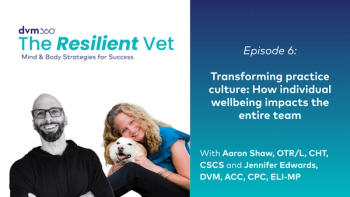
Climbing out of our emotional silo
Retreating to your emotional silo may feel safer, but it wont protect you long-term.
Anki Hoglund/Shutterstock.comMike Paul, DVM, recently wrote about
The word “silo” is commonly used in business contexts to describe a culture in which information is not shared among departments or other company sectors, often resulting in inefficiencies and mistakes. Workplace silos are generally viewed negatively, yet they're ubiquitous. So what purpose are they serving?
Think about a grain silo. In addition to providing storage, a grain silo protects its contents from excessive heat and humidity and from damage by pests. It's all about protection! With this in mind, we must ask ourselves what we're using emotional silos to protect us from in the workplace.
Dr. Paul wrote, “I can remember feeling that no success was enough. No matter what my clients said, I wasn't good enough. One shortfall equated with total failure.” It's often astounding to learn that highly accomplished people-those for whom I have tremendous respect and admiration-can suffer from the same afflictions I experience. They too can feel like they are not good enough.
For health professionals motivated by concern and compassion for others, the mere inference that our efforts are not appreciated can send us into a tailspin where we feel inadequate, unappreciated and even guilty.
For health professionals motivated by concern and compassion for others, the mere inference that our efforts are not appreciated (for example, when clients question a recommendation, complain about fees or reference something they read on the Internet) can send us into a tailspin where we feel inadequate, unappreciated and even guilty. And that feels lousy!
Consequently, it's perfectly natural (and sometimes beneficial) for us to consciously or unconsciously protect ourselves from such unpleasant emotional experiences. That's when we start erecting emotional silos.
Our emotional silos are constructed brick by brick over many years, and our experiences dictate the degree to which we fortify their walls. For example, hostile interactions can cause us to become excessively task- and data-oriented so we can avoid opening ourselves up and expanding our emotional repertoire. While functioning within this silo can feel safer, operating at this level day after day and year after year will likely lead to the
Unfortunately, many people see the “compassion trap,” which Dr. Paul describes as literally suffering with the other person (the word “passion” comes from the Latin passeo-to suffer), as the only alternative to an emotional silo. Those caught in the compassion trap go beyond wanting to help fix the problems that are causing stress for our patients and clients and end up jumping into their story. This can lead to brownout too.
But, wait-isn't veterinary medicine a compassionate profession? Isn't compassion good? The key is to distinguish between compassion and caring. We care about our patients, our clients, our staff and our colleagues, but caring doesn't require us to take their cares on our shoulders and suffer alongside them.
There is an alternative to retreating into an emotional silo that allows us to show caring without being sucked into the vortex of other people's (and pets') suffering. We can empathize! Empathy means being able to understand another person's circumstances-even experiencing how they feel-without taking responsibility for their feelings.
When we are empathetic, we can better help clients find their best solutions. For example, when a client's beloved pet is diagnosed with a terminal condition, the client can become overwhelmed and unable to determine the best course of action. Empathy allows us as veterinary professionals to acknowledge and validate our clients' perspective so they feel heard and understood before we explore next steps together.
Veterinary professionals can use empathy to learn what clients really want in the situation. For example, they could ask, “How do you want Sparky to experience the time you have left together?” This helps the pet owner and the veterinarian gain clarity on what matters most to the client and creates an opportunity for the veterinarian to suggest appropriate options.
When using empathy, there is less need to protect ourselves emotionally because we've helped our clients come up with their own best solutions.
When using empathy, there is less need to protect ourselves emotionally because we've helped our clients come up with their own best solutions. Both sides benefit. Naturally, this is easier said than done in many circumstances. As Dr. Paul stated, it comes down to awareness. We need to be aware of what triggers our protective responses and when we are trying to fix how the client is feeling. It also helps to keep in mind that our foibles, insecurities and desire for protection are completely normal.
I want to note that highly empathic individuals inherently sense and experience the feelings of others, and this can heighten their desire to fix others' troubles. Understanding and distinguishing caring empathy from compassion can allow highly empathic veterinary professionals to better serve clients with less risk for compassion fatigue and brownout. However, we can still choose to be compassionate, in the literal sense of the word, when the approach best serves the given situation. By making the choice mindfully and purposely, we can avoid the compassion trap while providing what is needed in the moment.
Dr. Mike Murray is a veterinarian and certified life and leadership coach. He is technical marketing director for Merial and has previously worked in both private and university veterinary practice.
Newsletter
From exam room tips to practice management insights, get trusted veterinary news delivered straight to your inbox—subscribe to dvm360.




